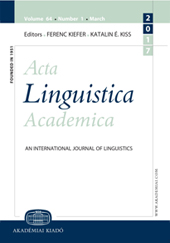Frequency and prototypicality determine variation in the Hungarian verbal 1 SG.INDEF
Frequency and prototypicality determine variation in the Hungarian verbal 1 SG.INDEF
Author(s): Péter RáczSubject(s): Morphology, Finno-Ugrian studies
Published by: Akadémiai Kiadó
Keywords: corpus linguistics; morphology; language variation and change; Hungarian
Summary/Abstract: I provide a synchronic account of the variation between the marked and unmarked forms of the 1SG.INDEF of Hungarian (-ik) verbs; verbs that end in (-ik) in the 3SG.INDEF. I use a generalised mixed-effects regression analysis to explore how these forms vary in an extensive sample of the language, the Hungarian Webcorpus. I find that verbs' preference for the marked/unmarked form is determined by their lemma frequency and their prototypicality as members of the (-ik) class. These results are consistent with a morphological levelling account of variation in Hungarian verbal morphology, in which verbs migrate away from the minority (-ik) class and into the majority regular class. This suggests a picture of variation in Hungarian verbs that is shaped by lexical organisation, morphophonology, and social dynamics.
- Issue Year: 66/2019
- Issue No: 4
- Page Range: 601-620
- Page Count: 20
- Language: English
- Content File-PDF

